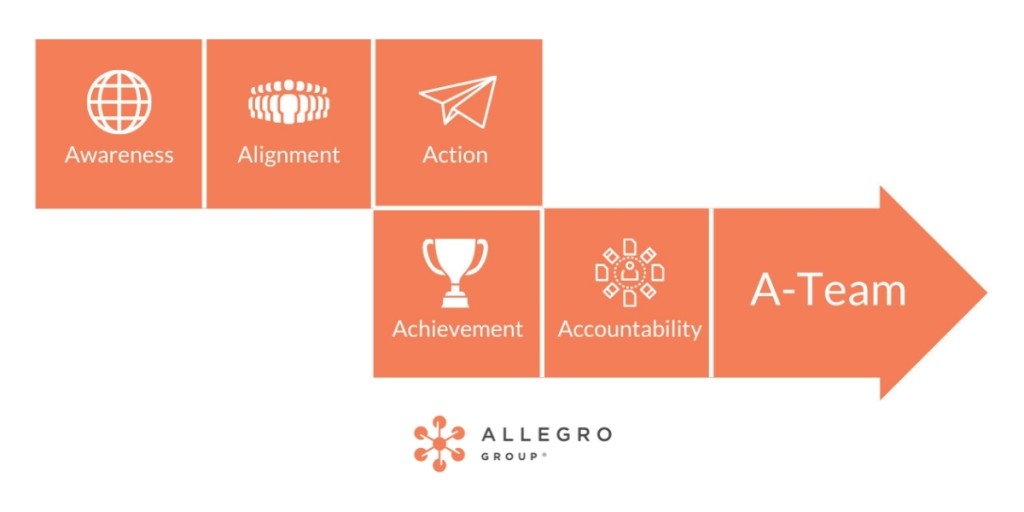By Kara Jorvig
Now past the worldwide lockdown due to the COVID-19 pandemic, the state of work has forever changed.
Top leadership has been forced into new priorities and expectations, both for themselves and their workforce. But what exactly are they? How do we define them? How do we know what to focus on?
According to a recent CNBC survey, top executives in HR, finance and technology indicate that nearly half of companies will utilize a hybrid work mode—some variation of remote and in-person working—for the rest of 2021. Only 32 percent indicated an “in-person first” strategy for the same timeframe.
Employee productivity and employee health and wellness appear to be the driving forces behind the changes in employer plans to go beyond the near term and even incorporate permanent hybrid work options. Offering hybrid or flexible work arrangements also gives employers a leg up when trying to attract top talent.
But creating and maintaining a good plan for hybrid work creates additional stressors for both the employer and the employee. As companies across the nation and the world juggle the creation of new employment options, leaders are grasping for solutions to problems they never foresaw. From how to measure productivity to helping parents navigate school restrictions to isolation and even depression in some remote workers, the landscape of work and its challenges have suddenly grown deeper and wider.
How do we move into this new paradigm with the least disruption and the most good accomplished? How do we redefine individual goals, schedules and action items? How do we reimagine participation and recognition of achievements? How do we develop cohesive teams?
It’s critical in times of uncertainty to pause, take a step back and assess the situation from all perspectives.
THE A-FRAMEWORK
For us at Allegro Group, the foundation for success regardless of circumstances involves a cooperative and empowering process between all leaders and their team members. To facilitate this, we use a process called the A-Framework.
We originally built the A-Framework to guide leaders and businesses as they navigate growth and advancement. It became such a powerful tool that we have continued to refine and apply it to other areas of business strategy. Today, we use it as a guiding tool for building high-performance teams and cultures.

BEGIN WITH AWARENESS
Our exclusive and powerful A-Framework process is divided into five components: Awareness, Alignment, Action, Achievement and Accountability. Awareness is the starting point for any kind of effective change. We need to understand where we are today in the area where we’re trying to navigate change.
Awareness has two components: internal and external. Internal awareness, especially for leaders, includes the ability to self-audit when necessary. Modeling the ability to choose a better path, monitor your emotions and demonstrate patience and self-control are all traits that create better leaders who, in turn, can pass on a workplace culture that embraces these traits. External awareness includes having an understanding of how you, your business and your team are perceived by others.
I always start by asking clarifying questions. In the case of navigating a hybrid work environment, ask yourself:
- What experiences have you had with this type of work arrangement?
- Have you seen or experienced success? Have you not had success?
- What frustrations or challenges have you had?
- What are your biases for, or against, hybrid work?
- Where is your business or team when it comes to hybrid work?
- How do your leaders manage people and projects today?
- How do your customers and business partners view your organization?
I spent much of my career in a traditional work environment, where your physical presence was required to get ahead. So, I have a bias toward in-person environments. Because I am aware of this personal bias, I have been able to adopt a growth mindset to the idea of hybrid and remote work, and this has opened a host of new possibilities.
ENSURE ALIGNMENT
Once you have established awareness, the next step in the A-Framework process is Alignment.
It may seem obvious that employees should embrace their company’s culture and be aware of and aligned with the company’s objectives and goals; however, the greater problem is that most companies don’t spend enough time developing, much less transmitting, a shared value system with consistent goals and objectives.
And certainly, if the leaders of a company don’t exhibit or don’t know its core values, their employees won’t either.
Alignment entails creating clarity around the business goals, skills and competencies necessary for effective hybrid work and then building commitment within the organization to the strategy put forth.
A cohesive hybrid work environment relies upon employees being autonomous and productive. Disengaged employees are unlikely to transform themselves into the empowered workforce companies need in the new normal. The best way to create an engaged workforce is to generate a healthy culture with clearly defined values that are communicated effectively down the chain.
PURPOSE-DRIVEN ACTION
Step 3 in the process is Action. It’s important to note that many leaders are really great at taking action. But it’s common for leaders to take action without pausing and reflecting on the first two steps: “Are we clear?” and “Are we aligned?”.
It feels good to take action! But action simply for the sake of action can create chaos. It is only when action is rooted firmly in the clarity of business goals and team and cultural alignment around those goals that action will result in positive gains for the organization.
When built upon the solid foundation of Awareness and Alignment, Action propels your organization forward. This step involves building the strategic roadmap needed to accomplish the business goals. The overarching goals must be broken down into SMART goals—Specific, Measurable, Attainable, Relevant and Time-bound.
The Action step should be considered more strategic than tactical. Tactical execution is included in the next step, Achievement. Within the Action step, the focus should be at a higher level, encompassing the entire roadmap needed.
The Action step should also include the change management processes necessary to navigate the many challenges hybrid work brings to an organization. These could include onboarding and employee response issues, productivity measurement, recognition opportunities and many others. In the new hybrid working environment, identifying and fleshing out these processes is critical.
Though not a magic pill by any means, technology can certainly bridge critical gaps in hybrid work. Technological solutions can also aid in Steps 4 and 5 of the A-Framework, known as Achievement and Accountability.
CREATE A SYSTEM FOR ACHIEVEMENT
Step 4, Achievement, is the tactical execution plan of the strategic goals defined in the prior step. This tactical plan includes the development of the systems needed to accomplish the goals, as well as the development of the KPIs (Key Performance Indicators) and scorecards for each goal.
Below are best practices recommended for considering and implementing technological solutions for your hybrid workforce.
- Use dashboards. Create a simple, shared system for tracking project status.
- Agree as a team on your choice of technology systems to avoid the confusion and double work of managing multiple tools that accomplish the same tasks.
- Set boundaries. Establish expectations for when and how quickly you expect people to respond to messages, as well as what days and times are off-limits.
- Plan brain breaks. With video meetings, it’s easy to schedule things so tightly that you find yourself rolling from one right into the next. Consider making the default meeting length 25 minutes or 50 minutes instead of 30 minutes or 1 hour.
But the Achievement step isn’t limited to defining work scopes, tactical plans and technology. The content, frequency and cadence of your communication is key to keeping your team interconnected.
It also should include a robust recognition program to reward employees when they reach those milestones and KPIs. Separation from co-workers can mean increased feelings of isolation, which can cause employees to feel under-appreciated and even unseen.
Consider creating an experiential rewards program designed around not only metrics and goal achievement but also around expressions of your company’s shared values and culture. Get to know what energizes your employees and brings them meaning, and be sure to include those elements.
Additionally, pulling the team together for informal get-togethers can also build cohesion and create memories from shared experiences. Some ideas include:
- Create a calendar of lunch-and-learns. Invite team members to take turns sharing about a topic they’re interested in that doesn’t tie directly to the business. Tap the person who’s an outstanding cook to share their strategies for planning delicious, healthy weekday meals, or ask the office athlete to provide at-home training tips. Invite people with a unique hobby to share their expertise and get everyone’s creative juices flowing.
- Send a gift. It can be easy to lose personal connections with team members who are working remotely. To counterbalance this, look for ways to show appreciation for those who are off-site. A card, a surprise lunch delivery or another fun treat will show you are thinking of them and value them as part of the team.
- When you can get together in person, make it special. Resist the urge to pack those days with back-to-back meetings. Include some time and space for strengthening team cohesion.
- Celebrate success, regardless of where the work is completed.
PRACTICE ACCOUNTABILITY
The final step in the A-Framework is Accountability. It can often be the hardest step. However, accountability, when presented as a component of shared values and a goal-minded team, can actually become a motivator of transformative work.
When Accountability is wrapped up in positive reinforcement, shared values, recognition and appropriate tools for self-accountability are provided, hybrid workers can actually begin to value and appreciate the Accountability step.
Inclusion, shared experiences, teamwork, cohesion and feeling valued are all part of developing a remote group into a tight unit that feels connected.
Understanding one’s place in the overall company strategy and being celebrated for helping the team meet shared goals is critical. Of course, this necessitates the development and communication of those shared values and the leadership culture that are foundational to accomplishing this step.
Tips for establishing this include:
- Onboarding all team members to the hybrid work arrangement appropriately
- Regular check-in meetings
- Leaders who ensure their teams can identify the work that needs to be done
- Clear feedback and candid conversations
EMBRACE THE POSSIBILITIES
For most organizations, this is a time of change. How we think about work and how we think about the future of our businesses has been disrupted.
We have an enormous opportunity to reimagine and redefine the workplace. With the right mindset and a framework for navigating those changes, we can lead our organizations toward new levels of growth and success.
Kara Jorvig is the founder and CEO of Allegro Group, a premier consulting, organizational development and talent acquisition firm. For nearly 20 years, she has partnered with CEOs and executive teams to help them assemble, activate and accelerate their A-Teams. For more from Kara, follow her on Instagram @kara.jorvig or LinkedIn @KaraJorvig and visit karajorvig.com.

